Water for Architecture
massa critica | davide tommaso ferrando
The following text was originally published in the book 1301iNN. Drawing, Building, Photography (Letteraventidue, 2013). In it, I speculate about the value and significance of a very small portion – a compluvium – of a beautiful building which, quite surprisingly (actually not surprisingly at all, especially given the winner), wasn’t even shortlisted in this year’s Gold Medal for Italian Architecture. I am grateful to Francesco Trovato for letting me re-publish it on OII+ (and to Antonella Bergamin for translating it in the first place).
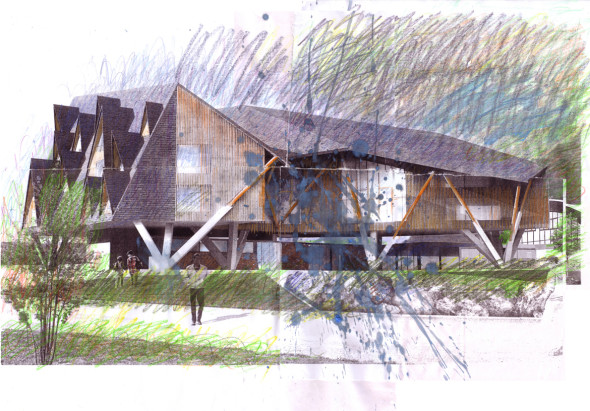
The nature of things betrays itself more readily under the vexations of art than in its natural freedom. (Francis Bacon)
The day of my visit to the 1301INN, Piancavallo was shrouded in a thin curtain of fog, now and then pierced by a cold autumn rain. A dozen builders were working on the last details of the building, then close to completion: they got in and out of its timber belly like a swarm of ants at work. I made a first tour of reconnaissance of the building, and it did not take me long to notice a particularly interesting detail: a great deal of rainwater drained from a specific spot (incidentally missing a dripstone or drainpipe) in the hotel’s roof, corresponding to the lowest level in the steep valley that defines the visible “depression” in the dynamic slate surface. The water jump thus generated fell on an area that would be soon occupied by the large heap of stones ‒ an outsized dripstone ‒ now placed in the concave space generated by the intersection of the two hotel wings. I turned to Stefano Pujatti who more or less told me: «Wait till winter and you will see what happens».
About five months after that first visit, the winter season has come, rain has fallen more frequently and abundantly, finally replaced by snow, and what was once a waterfall is now a massive ice column: a stalactite so tall that, over the months, drop after drop, it has finally reached the stone below. A new element in the mountain landscape around us (now a part of it), the 1301INN, and its waterfall/stalactite is a natural artifice: an intentional effect of that meticulous architectural device that is the hotel’s roof, the complex shape of which ‒ far from being a wishful plastic gesture ‒ results from the designers’ intention to make the building play with water, whether in the liquid (rain) or in solid (ice) state.
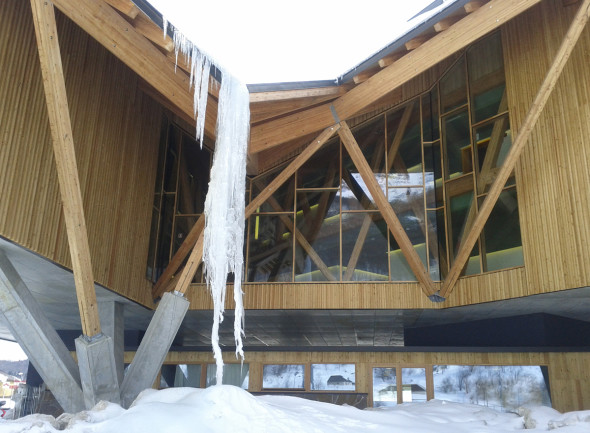 1301iNN (photo by Stefano Pujatti)
1301iNN (photo by Stefano Pujatti)
While I was preparing this text, I looked for precedents and possible references for such architectural device, trying to retrace the trajectories that have led ELASTICOSPA+3 to choose water as one of the main elements for its design, and to “work” on it in such an interesting manner. So I decided to develop the text around the thoughts resulting from this concept. Should anyone object that an entire essay about a roof valley is not that necessary, I would remind them that sometimes criticism, just like architecture, «is about giving the impression one talks about one thing while the matter of discussion is another»1.
When water’s temperature drops below 0ºC, its molecules acquire hexagonal geometries less efficient in a volumetric sense that make it less dense as it gets to the solid state. The transformation of a thermodynamic system from one state of aggregation to another is called «phase transition» ‒ in the case of water’s transition to ice it can simply be called solidification. Being an entirely natural process, its occurrence depends on the simultaneous presence of certain environmental (atmospheric and geometric) conditions not necessarily induced by man’s intervention. But, in order for such phenomenon to occur in a specific way, some parameters must be controlled artificially – in this case, the size and slope of the surfaces (roof pitches and valley) over which rainwater falls and flows –, in other words it is necessary to provide the environmental conditions that, during the solidification process, can ensure a certain formal result.
“the construction of the 1301INN’s large stalactite can be defined a reconstruction that celebrates the natural processes”
In this sense, the construction of the 1301INN’s large stalactite can be defined a reconstruction that celebrates the natural processes and is aimed at achieving a poetic expression (from the Greek poïesis – construction) of «water» as a material by a design action as elementary as the definition of two pitches and a valley. An action – this should be clear – that implies no artificial intervention on rainwater’s molecular properties ‒ no heating or freezing is involved ‒ only the architectural manipulation of the physical context the element simply and naturally interacts with – to use Gilles Clément’s words, there is a minimum expenditure of «contrary energy»2. For this reason, when rainwater becomes a stalactite, it totally remains “itself”, and merely takes a form inherent in its own nature, made possible by specifically prepared environmental conditions.
It is difficult not to be impressed by the result of such process, even when it is not the first time one sees an ice stalactite. One of the reasons for such wonder is the phenomenon’s unusual precision (unlike what we are used to see, rainwater is concentrated in one spot of the roof so that there is no dripping curtain of ice along the eaves line) – a precision that is all but natural. Such “sharpness of execution” betrays the large ice cone’s architectural origin as its ambiguous structure is simultaneously natural and man-made. A formal paradox due to the fact that water is forced to reveal a way of being that is its own but could hardly occur independently.
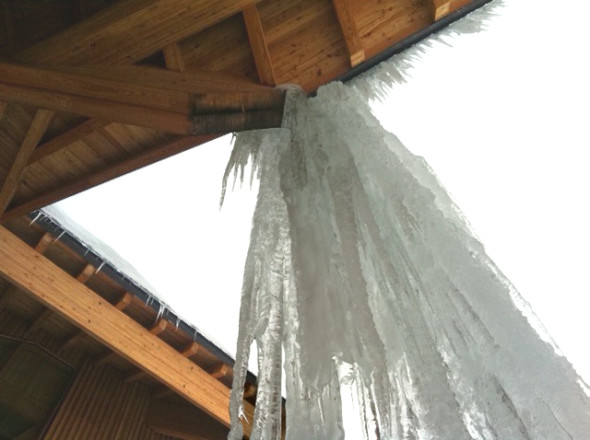 The ice stalactite (photo by Stefano Pujatti)
The ice stalactite (photo by Stefano Pujatti)
Channeled by the eaves’ layout and solidified by low temperature, water becomes a poetic material, in an example of the alchemic process described by Germano Celant in his 1969 book about Arte Povera. There he defined the artist as the one who «organizes living and vegetable matter into magic things, working to discover the root of things, in order to re-find them and extol them [since] what interests him is […] the discovery, the exposition, the insurrection of the magic and marvelous value of natural elements»3. The unavoidable connection between Arte Povera and ELASTICOSPA+3’s architecture, already proposed by influential voices in the past4 and certifiable in the experimental approach the Piedmont/Friuli-based designers usually apply to the reinterpretation of the materials used in its design: an effort of exploration that quite often translates into compositions, treatments and combinations that, through construction, can express unexpected aspects «of our universe, full of thousands of things which are worth of attention»5, as Alighiero Boetti used to say.
Based on the above reasoning, a certain correspondence – in terms of process rather than of result – can be legitimately seen between the works of artists of the Arte Povera movement and the roof valley-dripstone system designed by ELASTICOSPA+3 for the 1301INN.
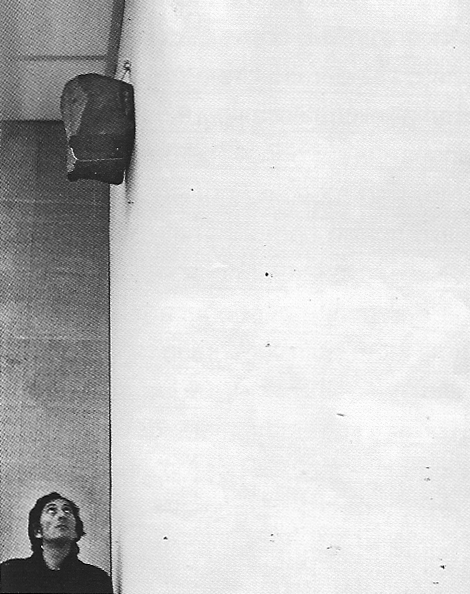 Giovanni Anselmo, Untitled, 1969
Giovanni Anselmo, Untitled, 1969
One of such examples could be Giovanni Anselmo’s Untitled (1969): a large block of granite hanging on a wall from a hook and a steel cable that binds it in a noose made tighter by the gravitational pull exerted by the stone itself – a work that, although built with few elements, conveys a vivid impression of what the force of gravity is, simply by “creatively” using a noose and a hook.
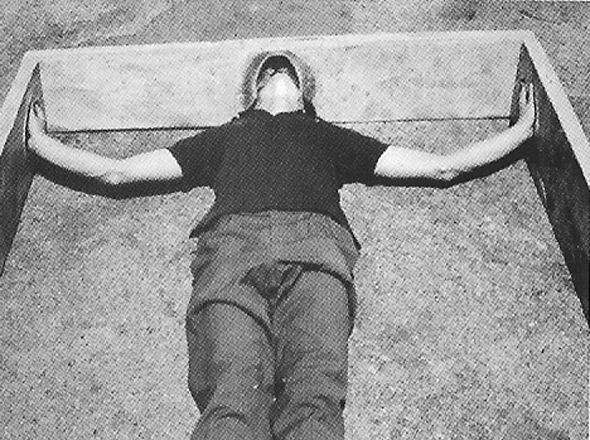
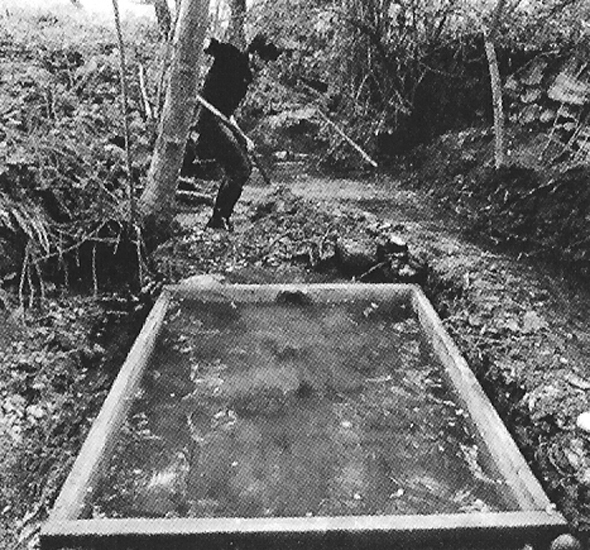 Giuseppe Penone, Maritime Alps: My height, the lenght of my arms, my width in a stream, 1968
Giuseppe Penone, Maritime Alps: My height, the lenght of my arms, my width in a stream, 1968
Another example could be Giuseppe Penone’s Maritime Alps: My height, the length of my arms, my width in a stream (1968): a concave cement mould of the artist’s own body lying in a stream through which water is temporarily made to flow so that it becomes an ephemeral “Water Penone” in constant transformation.
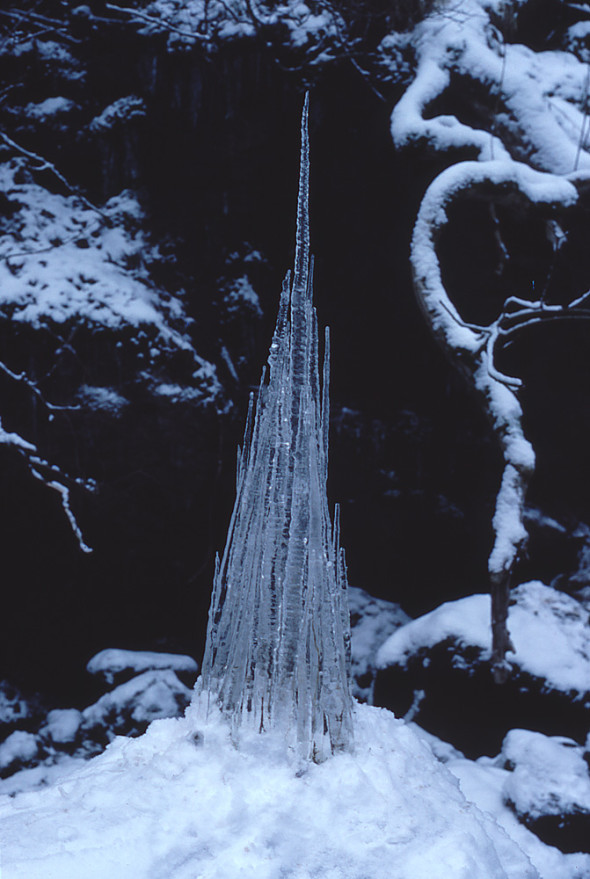 Andy Goldsworthy, Icicle Spire, 1985
Andy Goldsworthy, Icicle Spire, 1985
Finally, a particularly obvious reference is that to Andy Goldsworthy’s ice sculptures. The British artist works in natural environments (his works are always made in situ and later photographed) by arranging the natural elements according to new orders (heaps of egg-shaped stones, huge snowballs melting in the sun or fragile arches of ice) that are ambiguously integrated and alien to their contexts.
“the fact that architecture may use art for its own purposes does not mean that the two concepts are somehow interchangeable”
Having said this, all these parallels should not support the widespread misunderstanding according to which architecture should seek some kind of artistic status: the fact that architecture may use art for its own purposes does not mean that the two concepts are somehow interchangeable and, in spite of the influential voices that say the opposite is true, I think that in this context, in order to avoid any confusions, it is necessary and sufficient to call on Gotthold Ephraim Lessing’s distinction between «art» and «poetry»6 (the latter being the term architecture should be referred to).
After all, also in light of the above mentioned elective affinities, we are clearly looking at an architectural design that was conceived firmly within the history of the discipline it belongs to and with which it inevitably establishes, in its construction, a dialectics made of references and revivals. Such condition of critical diachronicity is not only related to the work as a whole: quite to the contrary, it can be recognized in many of the design’s constitutive elements – clearly including the above mentioned roof valley-dripstone system.
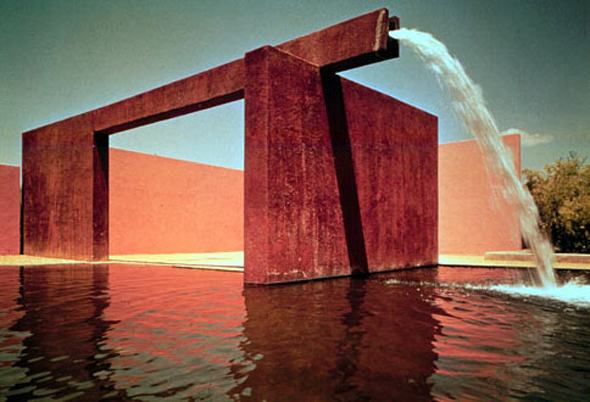 Luis Barragan, Fuente de Los Amantes, 1964
Luis Barragan, Fuente de Los Amantes, 1964
A small but well known architecture seems to convey better than most the latent spirit of this “corner” of the hotel in Piancavallo: Luis Barragan’s Fuente de Los Amantes (1964) – a horse pool with a wall in the middle, straddled by a cantilever beam perpendicular to it, that channels and throws a large jet of water in the fountain, powerfully rippling its horizontal surface.
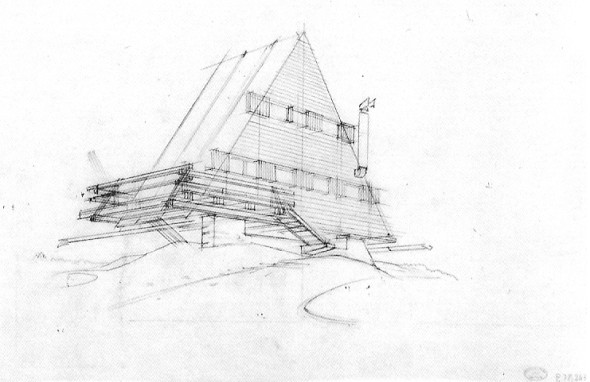 Carlo Mollino, Casa Capriata, 1951
Carlo Mollino, Casa Capriata, 1951
A second architectural reference – crucially important to understand the entire design – is the entire corpus of Alpine architectures designed and built by Carlo Mollino between the 1930s and the 1960s. In a critical opposition to the mimetic practices of his age, the Turin-based architect pursued a radical redefinition of the «problem of how to build in the mountains», that he interpreted as a reinterpretation of the codes of modern architecture through the integration of features typical of rural architecture such as the focus on landscape, the environment and local building constructions. In Mollino’s work, extreme weather conditions, steep sites and breathtaking landscapes in particular became inspirations for structural, spatial and functional schemes that pursued a total immersion in landscape. Mollino’s interest in the expressive potential of Alpine architecture is well represented by the roof of the Capriata House (1951) with its eaves inclined at such an angle that snow cannot rest on then. They represent the main – if not the only – design reference that – in a transformed and multiplied image – can be recognized in the dynamic folds of the 1301INN’s roof.
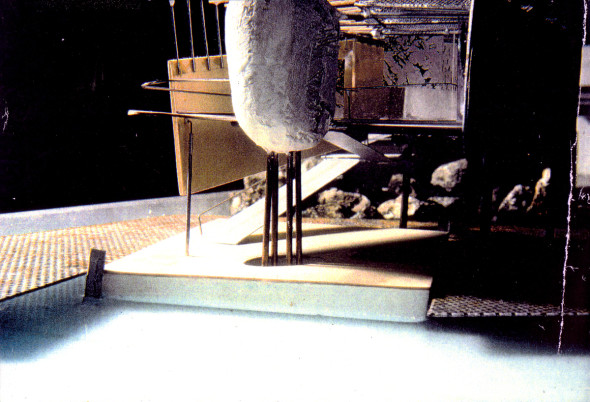 Stefano Pujatti, Sensible Building, 1994
Stefano Pujatti, Sensible Building, 1994
This is not the first time that ELASTICOSPA+3’s architectural research chooses the theme of water. A first experiment was the design study developed by Stefano Pujatti in 1994 for a building to be used for recreational activities during the winter and as a day centre for the elderly during the summer. Delicately reclining over the cliff that shelters the old centre of Caorle (near Venice), the Sensible Building (that is its name) is particular in that it changes shape according to the moon phases ‒ when the tide either rises or falls the sea partially invades its spaces, in a cyclic movement of physical and perceptive transfiguration that seemingly anticipates the seasonal process of solidification and melting of the 1301INN’s stalactite.
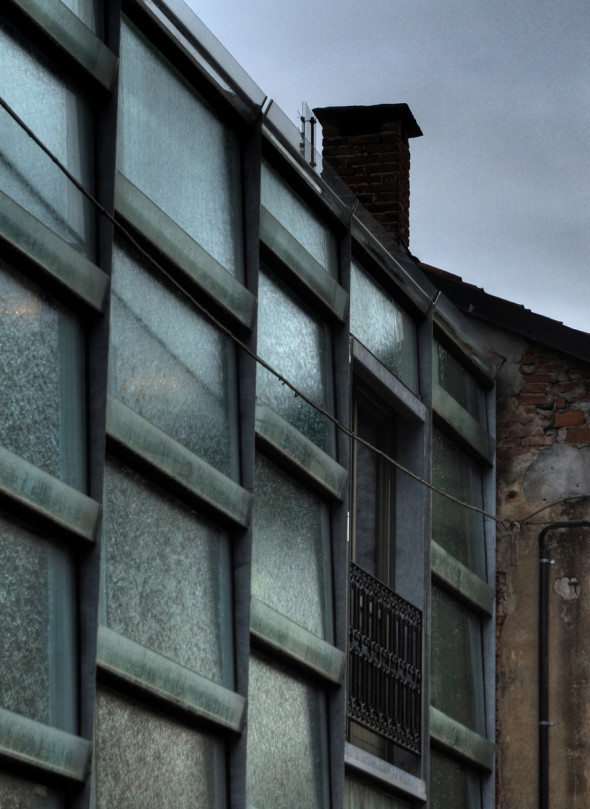 ELASTICOSPA, Atelier Fleuriste, 2009 (photo by Beppe Giardino)
ELASTICOSPA, Atelier Fleuriste, 2009 (photo by Beppe Giardino)
About fifteen years later, the theme of water returns at the Atelier Fleuriste (2009), a small commercial building erected to complete an urban front comprising a low-density and low-quality residential fabric, the volumes of which are reflected and reinterpreted by a glass envelope that embraces the spaces of the flower workshop. In this case, water takes the shape of a thin veil (produced by a hydraulic system placed on the roof) that slowly slides over the building’s envelope/store window so that its façade becomes a large fountain. The shop can only be imagined through the glass with the flow of water (incidentally also contributing to the building ‘s cooling) that blurs its spaces into picturesque spots of color.
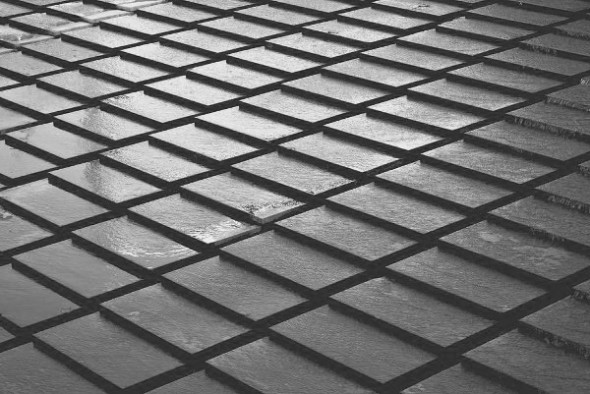 Gino Valle, Monument to the Resistance, 1969
Gino Valle, Monument to the Resistance, 1969
The Atelier Fleuriste’s façade is a silent homage to another – great – example of design exercise on water, and one of Italy’s most interesting works of twentieth century architecture: the Monument to the Resistance (1959-69) by Gino Valle, who was also Stefano Pujatti’s and Alberto del Maschio’s professor at the IUAV. The building solution with layered rectangular slabs adopted in ELASTICOSPA’s design indeed reinterprets (with a change of layout, vertical rather than oblique, and of material, glass in place of stone) the monumental fountain designed by Valle, with the water flowing on a large sloping plane of porphyry slabs that drowns the urban noise in the background with its roar, and, right in the middle of a roundabout, produces a strange effect of perceptive alienation from its context.
In 2011 a small book7 was published in Turin about Paul Valéry’s Eupalinos including a collection of meditations and original contributions about the famous French writer’s most “architectural” work. Stefano Pujatti’s contribution was an inspired (an subtly polemic) text, Architettura all’acqua, a title that hints at the difficult relationship between the Turin-based practice and this unstable element, a «difficult and nostalgic beast», all too often underestimated and abused by those who were called to design and protect it. The unusual pietas with which Pujatti approaches water in his short text seems to come from another place: a place of ideas that would never repose on a reality littered with «bottles, mucilage and buildings erected on eroded shores». A place where only one option is possible for it to become a reality: to become design.
Water is the enemy of modern architecture: it shapes roofs when we wish there were no roofs; it creates the necessity of eaves and downpipes; it rises to the surface in surprising ways; it washes on the windows and, as humidity, grows molds on interior and exterior walls. […] Water shapes, sculpts, smoothes, washes and erodes […]. In its transformation it takes ever shifting shapes, changes volume, becomes impalpable or massive, defines ever unpredictable and changing spaces. It is temperamental and knows no day or night, it changes mood regularly but at ever different times; it becomes depressed or exalted even threatening the city that owes its life to it, the place where water and architects make peace once more today.8
Davide Tommaso Ferrando
Notes
1. MANSILLA + TUÑON, Avviamento e oscillazione: imbuti e docce, in “El Croquis”, 106-107, 2001.
2. GILLES CLÉMENT, Manifesto del terzo paesaggio, Quodlibet, Macerata 2005.
3. GERMANO CELANT, Arte Povera, Gabriele Mazzotta Editore, Milan 1969.
4. In a text published by “Arch’it”, Pietro Valle noticed how ELASTICOSPA’s architectural references are often mediated by their interest in the contemporary arts, namely Pop Art, Land Art and Arte Povera.
5. Quoted in GLORIA MOURE, Alighiero Boetti, in GERMANO CELANT (ed.), Arte Povera 2011, Electa, Milan 2011, p. 142.
6. On this issue Antonio Miranda wrote: «Poetry is the necessary construction that pursues truth directly and, sometimes, on such path, encounters beauty in space-time. Art is the representation that pursues beauty directly in space. […] Thus, beauty is not a virtue of the true poet’s work; it is rather a prize for his building the truth. Great music – just like cinema and architecture (that relate with temporal space and action) – are poetic and, therefore, anti-artistic disciplines ». See ANTONIO MIRANDA, A todos los becarios de la reina. Ocho ensayos de estética civil, Biblioteca Nueva, Madrid 2011, p. 70.
7. EMANUELA GIUDICE, ALBERTO ROSSO (eds.), Paradossi dell’architettura. Intorno all’Eupalinos di Paul Válery, Celid, Turin 2011.
STEFANO PUJATTI, Architettura all’Acqua, in ibid., p. 72.
Questo sito usa Akismet per ridurre lo spam. Scopri come i tuoi dati vengono elaborati.

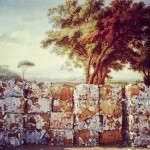
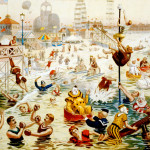
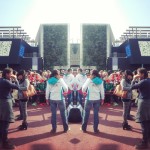




Lascia un commento